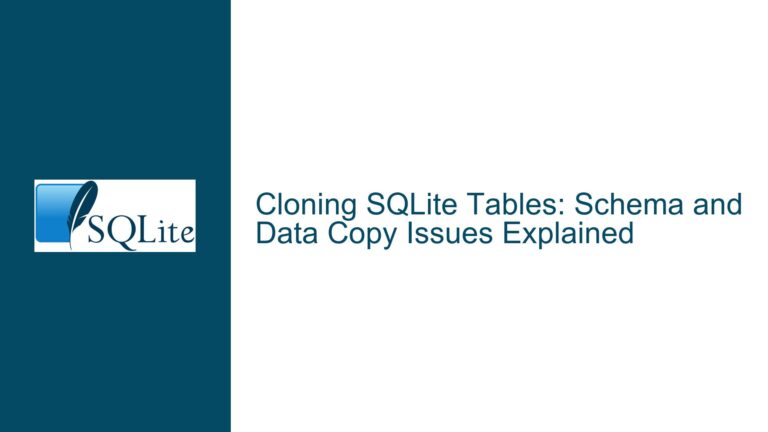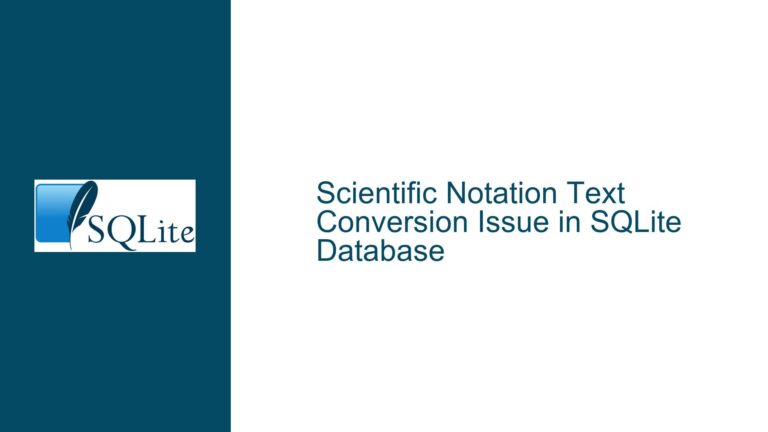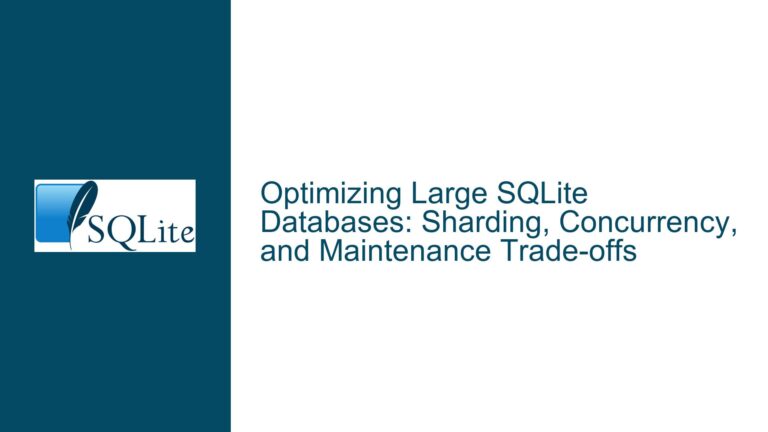Concurrent Writes in SQLite: Challenges, Causes, and Solutions for WAL3 Implementation
Issue Overview: Concurrent Writes in SQLite and the WAL3 Proposal
SQLite is a widely used embedded database engine known for its simplicity, reliability, and lightweight design. However, one of its notable limitations is the lack of native support for concurrent writes in multi-threaded or multi-process environments. This limitation can significantly hinder performance in write-intensive applications, such as those involving high-frequency data logging, real-time analytics, or distributed systems. The current Write-Ahead Logging (WAL) mode in SQLite allows concurrent reads but restricts writes to a single process at a time. This restriction can lead to bottlenecks in scenarios where multiple processes or threads need to write to the database simultaneously.
The WAL3 proposal aims to address this limitation by introducing a new journaling mode that supports concurrent writes while maintaining the benefits of the existing WAL and WAL2 modes. WAL3 is designed to allow multiple processes or threads to write to the database concurrently, thereby improving write throughput and scalability. However, implementing concurrent writes in SQLite is not without challenges. The proposal raises several technical concerns, including file system limitations, lock management, checkpointing, and the handling of auto-incrementing row IDs in a concurrent environment.
The core issue revolves around ensuring data consistency, avoiding race conditions, and maintaining performance while allowing multiple writers. The WAL3 proposal introduces new mechanisms for lock management, file truncation, and checkpointing, but these mechanisms must be carefully designed to avoid introducing new bottlenecks or data corruption risks. Additionally, the proposal highlights the need for changes in how SQLite handles row IDs in concurrent write scenarios, as traditional auto-incrementing IDs can lead to conflicts and performance degradation.
Possible Causes: Why Concurrent Writes Are Challenging in SQLite
The challenges of implementing concurrent writes in SQLite stem from several fundamental aspects of its design and the underlying file systems it operates on. Below are the key factors that contribute to these challenges:
File System Limitations: SQLite relies on the host file system for storing database files and journaling logs. File systems vary widely in their support for operations like file truncation, locking, and atomic writes. For example, the WAL3 proposal assumes that file truncation is a fast operation, but this may not be true on all platforms, particularly on Windows. Inconsistent file system behavior can lead to performance bottlenecks or data corruption in concurrent write scenarios.
Lock Management: SQLite uses file-level locks to manage access to the database. In the current WAL mode, an exclusive lock is required for writes, which prevents other processes from writing simultaneously. The WAL3 proposal introduces shared locks on the WAL3 file to allow concurrent writes, but this requires careful coordination to avoid race conditions. For example, if two processes attempt to write to the WAL3 file simultaneously, they must ensure that their writes do not overlap or interfere with each other.
Checkpointing Overhead: Checkpointing is the process of transferring data from the WAL file to the main database file. In WAL3, checkpointing becomes more complex because multiple processes may be writing to the WAL3 file simultaneously. The proposal introduces a new mechanism for handling checkpoints, including a
WAL3_FORCE_CHECKPOINTpragma, but this adds complexity and potential performance overhead. If checkpointing is not handled efficiently, it can become a bottleneck in high-concurrency scenarios.Row ID Management: In SQLite, each row in a table is assigned a unique row ID, which is often used as a primary key. In a concurrent write environment, managing row IDs becomes challenging because multiple processes may attempt to insert rows simultaneously. The traditional approach of using auto-incrementing row IDs can lead to conflicts and performance degradation. The WAL3 proposal suggests using pseudo-random row IDs to avoid these issues, but this requires changes to how SQLite generates and manages row IDs.
Cross-Platform Compatibility: SQLite is designed to be cross-platform, but different platforms have different file system behaviors and performance characteristics. For example, the WAL3 proposal assumes that file truncation is fast, but this may not be true on all platforms. Ensuring consistent behavior across platforms adds complexity to the implementation.
Backward Compatibility: Any changes to SQLite’s journaling mode or lock management must maintain backward compatibility with existing applications. The WAL3 proposal introduces new pragmas and file formats, which may require changes to existing applications or libraries that interact with SQLite.
Troubleshooting Steps, Solutions & Fixes: Implementing Concurrent Writes in SQLite with WAL3
Implementing concurrent writes in SQLite requires addressing the challenges outlined above while ensuring data consistency, performance, and cross-platform compatibility. Below are detailed steps and solutions for implementing the WAL3 proposal:
File System Optimization: To address file system limitations, the WAL3 implementation should include platform-specific optimizations. For example, on platforms where file truncation is slow, the implementation could use alternative mechanisms for managing WAL3 file size, such as pre-allocating file space or using memory-mapped files. Additionally, the implementation should include fallback mechanisms for platforms that do not support fast file truncation, allowing WAL3 to degrade gracefully to WAL or WAL2 mode.
Enhanced Lock Management: The WAL3 proposal introduces shared locks on the WAL3 file to allow concurrent writes. To avoid race conditions, the implementation should use fine-grained locking mechanisms, such as range locks or byte-range locks, to ensure that writes to the WAL3 file do not overlap. Additionally, the implementation should include robust error handling to detect and recover from lock contention or deadlock scenarios.
Efficient Checkpointing: To minimize checkpointing overhead, the WAL3 implementation should use background checkpointing, where checkpointing is performed asynchronously by a dedicated thread or process. This would allow writes to continue while checkpointing is in progress, reducing contention and improving performance. The
WAL3_FORCE_CHECKPOINTpragma should be used sparingly and only when necessary to avoid excessive checkpointing.Pseudo-Random Row IDs: To address the challenges of row ID management in a concurrent write environment, the WAL3 implementation should use pseudo-random row IDs by default. This would avoid conflicts and improve performance by reducing contention for auto-incrementing row IDs. The implementation should also provide an option to use traditional auto-incrementing row IDs for backward compatibility, but this option should be clearly documented as having potential performance implications in high-concurrency scenarios.
Cross-Platform Testing: To ensure consistent behavior across platforms, the WAL3 implementation should include extensive cross-platform testing. This testing should cover a wide range of file systems and operating systems, including Windows, Linux, and macOS. Any platform-specific optimizations or fallback mechanisms should be thoroughly tested to ensure they work as expected.
Backward Compatibility: To maintain backward compatibility, the WAL3 implementation should include mechanisms for detecting and handling older database files and journaling modes. For example, if a database is opened in WAL3 mode but the WAL3 file is not present, the implementation should automatically fall back to WAL or WAL2 mode. Additionally, the implementation should provide clear documentation and migration guides for applications that need to transition to WAL3 mode.
Performance Monitoring and Tuning: The WAL3 implementation should include built-in performance monitoring and tuning mechanisms. For example, the implementation could provide pragmas or configuration options for adjusting the size of the WAL3 file, the frequency of checkpointing, or the behavior of lock management. These options would allow users to fine-tune the performance of WAL3 mode for their specific use cases.
Community Feedback and Iteration: Finally, the WAL3 implementation should be developed in close collaboration with the SQLite community. This would allow for early feedback and iterative improvements based on real-world use cases. The implementation should include detailed documentation, examples, and best practices to help users adopt WAL3 mode and take full advantage of its benefits.
By addressing these challenges and implementing the solutions outlined above, the WAL3 proposal has the potential to significantly enhance SQLite’s capabilities in high-concurrency, write-intensive scenarios. However, careful design, thorough testing, and community collaboration will be essential to ensure that WAL3 meets the needs of its users while maintaining SQLite’s reputation for reliability and performance.






